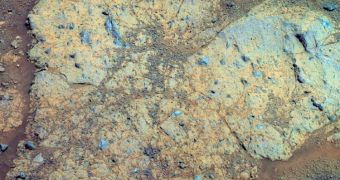New data relayed to Earth by the NASA Mars Exploration Rover (MER) Opportunity indicate that it discovered an interesting rock, which may hold telltale signs of past water flows on the Red Planet. The formation is called Chester Lake, and has been under scrutiny since last week.
Since arriving at the rim of Endeavour Crater – its target for the past three years – the rover managed to complete an in-depth analysis of a rock called Tisdale 2. The machine took spectrometric readings of the object, and even probed it with the abrasion tool on its robotic arm.
Opportunity made its way to Endeavour in August, after driving in excess of 33 kilometers since landing on Mars, in January 2004. When the machine landed, some 7-and-a-half years ago, no one expected it to get this far, and actually reach the massive crater.
However, it managed to do just that in August, after spending the last three years on a direct course for the impressive landscape feature. The crater interests astronomers because it reveals many geological layers to which the robot will have not had access to otherwise.
What is interesting about the new study target is that Chester Lake appears to be significantly older than most other geological formations that Opportunity studied since its science mission began.
“We've never seen a rock that looks remotely like this on Mars before,” said Steve Squyres, who is the principal investigator of the MER science mission, at a recent luncheon. He holds an appointment as a professor of geology at the Cornell University, in Ithaca, New York, Space reports.
“Opportunity is just a really well-made vehicle. It's way, way beyond warranty. It was supposed to drive about 600 meters and so far it's gone 33,500 meters in round numbers, and has taken maybe 150,000 pictures by now,” Ray Arvidson explains.
The investigator – a planetary scientist at the Washington University in St. Louis – is also the deputy principal investigator of the two rovers. NASA has ceased contact with Spirit earlier this year, after the robot was not able to survive its fourth Martian winter.
At this point, everyone's attention is turned to Opportunity, and the impressive chance it has to shed some light on the Red Planet's climate past. “The ancient rim of Endeavour represents a period when there was probably a lot more water on the surface,” Arvidson explains.
“So, we're trying to get the chemical, mineralogical and geological setting to 'back out' those ancient conditions to reconstruct environmental conditions during this earlier time period,” he goes on to say.
Thus far, the science team controlling the rover determined that Chester Lake contains numerous, broken fragments of separate rocks that came together following a catastrophic event – such as an asteroid impact.
The chemical analysis of the substances that make up this object will be conducted with the abrasion tool and related components. Experts already expect to find clays inside the interesting rock.
“Clays form in more neutral, less acidic conditions than the sulfate-rich sandstones we've been looking at. Our hypothesis is that if there are clay minerals, the water was less acidic and therefore more conducive to life,” Arvidson concludes.

 14 DAY TRIAL //
14 DAY TRIAL //